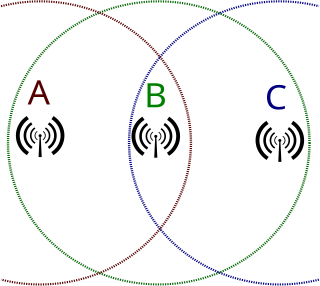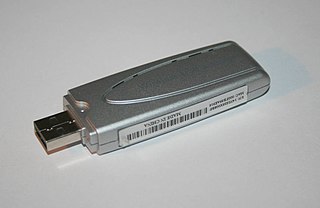Wireless networks in Hobart
The predominant network in Hobart is called StarNet. This was started as a private network by a small group of amateur radio enthusiasts, around April 2002. It included around six or seven sites.
In April 2003, an operator of the TasWireless website stumbled upon one of their nodes, with SSID StarNet, and posted his find to the mailing list.
As a result, all users involved were able to share knowledge and make some minor changes to the network routing. Another network RexNet, based in Kingston was also found; they had already been working with the StarNet group to eventually join the networks.
In mid-2003, various 802.11b wireless access points appeared on the market at low prices - Svec and Minitar brand access points were selling for around $100. This made setting up nodes easier, as the compatibility issues between various brands of PCI cradles, PC cards, and operating systems caused some problems.
By the start of March 2004, there were around 25 nodes on StarNet, reaching from Tea Tree, Otago, Rosetta, Lutana, Glenorchy, Moonah, Lindisfarne, Lenah Valley, Bellerive, Acton, Tranmere, Sandy Bay and Kingston.

IEEE 802.11 is part of the IEEE 802 set of local area network (LAN) technical standards, and specifies the set of medium access control (MAC) and physical layer (PHY) protocols for implementing wireless local area network (WLAN) computer communication. The standard and amendments provide the basis for wireless network products using the Wi-Fi brand and are the world's most widely used wireless computer networking standards. IEEE 802.11 is used in most home and office networks to allow laptops, printers, smartphones, and other devices to communicate with each other and access the Internet without connecting wires. IEEE 802.11 is also a basis for vehicle-based communication networks with IEEE 802.11p.

Wireless community networks or wireless community projects or simply community networks, are non-centralized, self-managed and collaborative networks organized in a grassroots fashion by communities, non-governmental organizations and cooperatives in order to provide a viable alternative to municipal wireless networks for consumers.

Wi-Fi is a family of wireless network protocols based on the IEEE 802.11 family of standards, which are commonly used for local area networking of devices and Internet access, allowing nearby digital devices to exchange data by radio waves. These are the most widely used computer networks, used globally in home and small office networks to link devices and to provide Internet access with wireless routers and wireless access points in public places such as coffee shops, hotels, libraries, and airports to provide visitors.

In computer networking, a wireless access point, or more generally just access point (AP), is a networking hardware device that allows other Wi-Fi devices to connect to a wired network or wireless network. As a standalone device, the AP may have a wired connection to a switch or router, but, in a wireless router, it can also be an integral component of the router itself. An AP is differentiated from a hotspot, which is a physical location where Wi-Fi access is available.

Launceston is a city in the north of Tasmania, Australia, at the confluence of the North Esk and South Esk rivers where they become the Tamar River (kanamaluka). As of 2021, the Launceston urban area has a population of 90,953. Launceston is the second most populous city in Tasmania after the state capital, Hobart. As of 2020, Launceston is the 18th largest city in Australia. Launceston is the fifth-largest inland city and the ninth-largest non-capital city in Australia. Launceston is regarded as the most livable regional city, and was one of the most popular regional cities to move to in Australia from 2020 to 2021. Launceston was named Australian Town of the Year in 2022.

In wireless networking, the hidden node problem or hidden terminal problem occurs when a node can communicate with a wireless access point (AP), but cannot directly communicate with other nodes that are communicating with that AP. This leads to difficulties in medium access control sublayer since multiple nodes can send data packets to the AP simultaneously, which creates interference at the AP resulting in no packet getting through.

Kismet is a network detector, packet sniffer, and intrusion detection system for 802.11 wireless LANs. Kismet will work with any wireless card which supports raw monitoring mode, and can sniff 802.11a, 802.11b, 802.11g, and 802.11n traffic. The program runs under Linux, FreeBSD, NetBSD, OpenBSD, and macOS. The client can also run on Microsoft Windows, although, aside from external drones, there's only one supported wireless hardware available as packet source.

A wireless network interface controller (WNIC) is a network interface controller which connects to a wireless network, such as Wi-Fi, Bluetooth, or LTE (4G) or 5G rather than a wired network, such as an Ethernet network. A WNIC, just like other NICs, works on the layers 1 and 2 of the OSI model and uses an antenna to communicate via radio waves.

Wireless security is the prevention of unauthorized access or damage to computers or data using wireless networks, which include Wi-Fi networks. The term may also refer to the protection of the wireless network itself from adversaries seeking to damage the confidentiality, integrity, or availability of the network. The most common type is Wi-Fi security, which includes Wired Equivalent Privacy (WEP) and Wi-Fi Protected Access (WPA). WEP is an old IEEE 802.11 standard from 1997. It is a notoriously weak security standard: the password it uses can often be cracked in a few minutes with a basic laptop computer and widely available software tools. WEP was superseded in 2003 by WPA, a quick alternative at the time to improve security over WEP. The current standard is WPA2; some hardware cannot support WPA2 without firmware upgrade or replacement. WPA2 uses an encryption device that encrypts the network with a 256-bit key; the longer key length improves security over WEP. Enterprises often enforce security using a certificate-based system to authenticate the connecting device, following the standard 802.11X.

High-speed multimedia radio (HSMM) is the implementation of high-speed wireless TCP/IP data networks over amateur radio frequency allocations using commercial off-the-shelf (COTS) hardware such as 802.11 Wi-Fi access points. This is possible because the 802.11 unlicensed frequency bands partially overlap with amateur radio bands and ISM bands in many countries. Only licensed amateur radio operators may legally use amplifiers and high-gain antennas within amateur radio frequencies to increase the power and coverage of an 802.11 signal.

The Tasmanian State League (TSL), colloquially known as the Tasmanian Football League (TFL) (formerly known as the Tasmanian Australian National Football League (TANFL) and several other short-term names) is the highest ranked Australian rules football league in Tasmania, Australia.

ORiNOCO was the brand name for a family of wireless networking technology by Proxim Wireless. These integrated circuits provide wireless connectivity for 802.11-compliant Wireless LANs.

Rail transport in Tasmania consists of a network of narrow gauge track of 1,067 mm reaching virtually all cities and major towns in the island state of Tasmania, Australia. Today, rail services are focused primarily on bulk freight, with no commercial passenger services being operated. The mainline railways of Tasmania are currently operated by TasRail, a Government of Tasmania-owned Corporation, who owns and maintains both rolling stock, locomotives, and track infrastructure.

Metro Tasmania, commonly called Metro, a Tasmanian Government business enterprise, is the largest bus operator in the state of Tasmania, Australia, with operations in three of the four largest urban centres of Hobart, Launceston, and Burnie. Urban services in Devonport are provided by a private operator, Kinetic. Services are provided by Metro under a range of urban and non-urban contracts with the Transport Commission, a division within the Department of State Growth.
Wireless tools for Linux is a collection of user-space utilities written for Linux kernel-based operating systems to support and facilitate the configuration of device drivers of wireless network interface controllers and some related aspects of networking using the Linux Wireless Extension. The Wireless tools for Linux and Linux Wireless Extension are maintained by Jean Tourrilhes and sponsored by Hewlett-Packard.

Seven is an Australian television network distributed by Southern Cross Austereo (SCA) in Tasmania, Darwin, the Spencer Gulf, Broken Hill, and remote eastern and central Australia. SCA's network is the primary affiliate of the Seven Network in the areas it serves.
IEEE 802.11a-1999 or 802.11a was an amendment to the IEEE 802.11 wireless local network specifications that defined requirements for an orthogonal frequency-division multiplexing (OFDM) communication system. It was originally designed to support wireless communication in the unlicensed national information infrastructure (U-NII) bands as regulated in the United States by the Code of Federal Regulations, Title 47, Section 15.407.
The 1924 Hobart Carnival was the fifth Australian National Football Carnival, an Australian football interstate competition. It was held from 6–15 August and was the first carnival to be hosted by the Tasmanian city of Hobart. It was won by Victoria.
The Tasmanian State Premiership was an Australian rules football tournament which was contested at the conclusion of the season, initially between the reigning Tasmanian Football League (TFL/TANFL) and Northern Tasmanian Football Association (NTFA) premiers, and then from 1950 also by the NWFU premiers, to determine an overall premier team for the state of Tasmania. The state premiership was contested 57 times between 1909 and 1978.
IEEE 802.11s is a wireless local area network (WLAN) standard and an IEEE 802.11 amendment for mesh networking, defining how wireless devices can interconnect to create a wireless LAN mesh network, which may be used for relatively fixed topologies and wireless ad hoc networks. The IEEE 802.11s task group drew upon volunteers from university and industry to provide specifications and possible design solutions for wireless mesh networking. As a standard, the document was iterated and revised many times prior to finalization.














